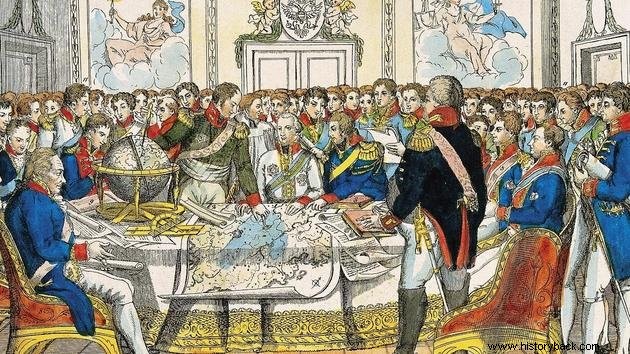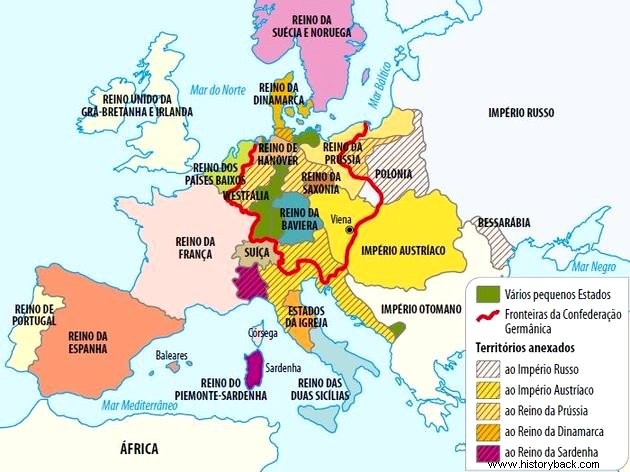The Congress of Vienna took place between November 11, 1814 and June 9, 1815 and reorganized Europe after the Napoleonic Wars.
In addition, decisions were taken that affected Brazil, such as the handing over of Guyana to France and the condemnation of trafficking in enslaved persons.
The Congress of Vienna served to keep Europe safe from major confrontations until the First World War in 1914.
Background of the Congress of Vienna

The governments of Austria, Prussia, Russia and Great Britain signed the Treaty of Chaumont in March 1814, shortly after the defeat of Napoleon Bonaparte in Russia.
In April of the same year, Bonaparte abdicated the French throne and went into exile on the island of Elba, off the Italian coast.
Later, at the invitation of the victorious powers, other countries joined the treaty, such as France, Sweden, Portugal and Spain.
The Treaty of Chaumont established that all governments should send representatives to an international meeting to be held in Vienna.
However, in the meantime, Bonaparte escapes the island of Elba and tries to defeat his enemies by fighting the Battle of Waterloo. The strategy fails and the former emperor abdicates and is arrested by the British.
See also:The Battle of WaterlooHoly Alliance
Before the Congress of Vienna was held, Russian Emperor Alexander I proposed the creation of the Holy Alliance. This would be formed by Prussia, Austria and Russia. Later, Great Britain would be incorporated.
Therefore, it was decided that these four nations would be responsible for the decisions on the future of the territories that had been conquered by Napoleon Bonaparte.
Faced with the reaction of other countries, the opening of the Congress of Vienna, scheduled for September 24, only took place on November 11.
See also:Holy AllianceObjectives of the Congress of Vienna
The priorities of the Congress of Vienna were to end the vestiges of the French Revolution and the Napoleonic Era.
The intention was to redraw the borders of France, the Italian Peninsula and the German states, and to restore the Bourbon family in France, Spain and the Kingdom of Naples.
In the same way, topics such as the abolition of the slave trade and the use of slave labor in the American colonies were discussed.
See also:Napoleonic eraMain decisions of the Congress of Vienna

Among the main decisions of the Congress of Vienna are the European territorial reorganization and the isolation of France as a way to avoid new wars.
Great Britain
Britain received as compensation the territories occupied by France, such as Mauritius, Tobago and Saint Lucia. On the part of Holland, Ceylon was ceded to him; and from Spain, the island of Trinidad.
It also incorporated some islands like Malta and the Ionians into her kingdom.
Great Britain was the great victor with the defeat of Napoleon Bonaparte. Once peace was concluded, the British boosted their industrial development and set out to conquer new territories.
France
Through the Treaty of Paris, the Bourbon dynasty returns to reign in France, in the person of Louis XVIII, brother of Louis XVI.
Part of French territory was occupied by the Holy Alliance for three years and France had to pay compensation to the victors.
As for the territory, the country returned to the borders of 1791. Even so, it received Guyana back from Portugal; Guadeloupe, from Sweden; Martinique and the Isle of Bourbon (present-day Reunion), from Great Britain.
Austria
Austria, along with Great Britain, will be the great European power after the conflict.
It occupies the northern territories of the Italian Peninsula, such as Venice, Lombardy and Milan, as well as three provinces of Illyria, Dalmatia and the port of Cattaro.
Galicia, from Poland, was also annexed to Austria; but Tyrol and Salzburg were handed over to German territories.
German States
Bonaparte had extinguished one of the oldest empires in the world:the Holy Roman Empire.
During the Congress of Vienna, to satisfy the territorial demands of the Russian Empire and Austria, the German Confederation was created. Thus, the number of German states went from 300 to 39.
Prussia
In turn, Prussia incorporated a number of German states and became the strongest country of Germanic culture.
It received half of Saxony, the Grand Duchy of Berg, part of the Duchy of Westphalia, and some cities like Cologne, Trèves and Aachen.
It also brought together part of Swedish Pomerania and annexed Polish territories.
Russia
Russia occupied most of Poland as the Grand Duchy of Warsaw. In turn, Krakow became a free territory, under the protection of Russia, Austria and Prussia.
Finland and Bessarabia (now Moldova) were kept within Russian territory.
Poland
Poland loses its independence and is divided between Russia and Prussia.
Italian Peninsula
Several regions of the Italian Peninsula had been divided between the brothers of Napoleon Bonaparte. Therefore, it was decided to restore the old dynasties to their thrones and create new states.
Thus, King Ferdinand IV, who reigned over Naples and Sicily, was once again recognized as sovereign with the union of his two kingdoms, now called the Kingdom of the Two Sicilies.
Austria, wanting to guarantee its exit to the sea, occupied several territories on the coast and in northern Italy.
The Kingdom of Sardinia incorporated the Republic of Genoa in order to form a strong state that could isolate France.
More curious was the case of Napoleon's ex-wife, Empress Maria Luisa. She became Duchess of Parma, Piacenza and Guastella and in exchange, their son Napoleon II was taken to be educated at the Viennese court.
Portugal
To participate in the Congress of Vienna, the Portuguese court declares the elevation of Brazil to the United Kingdom of Portugal and the Algarves. At this moment, Brazil is formally no longer a colony.
Portugal had to vacate Guyana and this territory returned to France.
See also:Johannine PeriodSpain
In Spain, the reign of Ferdinand VII, who had abdicated in favor of Napoleon Bonaparte, is re-established. The country lost the Caribbean island of Trinidad to Great Britain.
Slave Traffic
In February 1815, the Congress of Vienna condemned the slave trade for incompatibility with Christian and European civilization.
This decision will directly impact the Kingdom of Brazil, Portugal and the Algarves, as Brazil's workforce was mainly slave.
From there, the first laws restricting the slave trade in the Atlantic will be published.
See also:Abolition of Slavery in BrazilConsequences of the Congress of Vienna
The participating nations created a new European political organization, replacing the Treaty of Utrecht in 1713.
To solve the occupations that took place during the Napoleonic Empire, between 1815 and 1822, an order based on the cooperation of states emerged, a model that appeared for the first time in history.
The new system sought to balance the power of European nations, carrying out a policy of allies and territorial compensation.
The Congress of Vienna, in this sense, was efficient, as Europe would only enter a total war a century later with the First World War in 1914.
